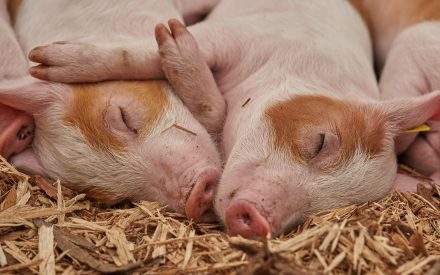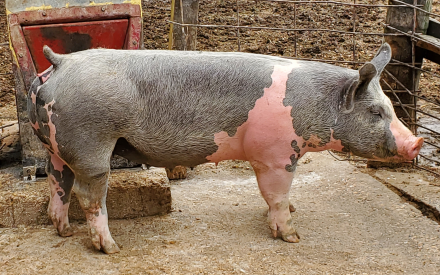Ractopamine-Free Series
Adapted with permission from Ohio State University Extension, “A Ractopamine-Free Swine Project”
Introduction
Ractopamine-free swine production is now a market specification/requirement throughout much of the U.S. pork packing industry. Ractopamine (sold under the trade names Paylean® or Engain® for swine, and Optaflexx® or Actogain® for cattle and other generic derivatives) is an approved product used to increase lean growth rate. The use of ractopamine in pig diets has specifically been banned in many international pork and pork product markets. Ractopamine remains an FDA approved product that can be legally fed in the U.S. at approved levels and approved time periods in the life of a market-destined hog, but restrictions from trade partners have led to its removal from most production systems. Many U.S. pork packers have determined they will not purchase ractopamine-fed pigs in order to meet market demands, maintain trade requirements, and help protect markets that account for upwards of 25% of the total value of annual U.S. pork sales. In response, proper processes to remove ractopamine are needed in all instances where the pork (meat) or pork products (internal organs, blood, fat, etc.) may enter a market that has been designed as ractopamine-free. Swine producers, exhibitors, feed industry participants, and transportation participants all maintain a role when meetings the packer specification for ractopamine-free swine. Steps you can take as a pig producer and industry participant to assist removal of ractopamine from your pigs’ feed and environment, and which may provide access to ractopamine-free markets, are outlined below.
What is Ractopamine Hydrochloride?
A beta-adrenergic agonist that when fed according to label directions can improve pig growth rate, carcass composition and feed conversation efficiency.
What does Ractopamine-Free Mean?
The pig has never been fed or exposed to ractopamine sources from birth to harvest.
Ractopamine Removal (Focal Areas) Your pig:
Whether you purchase or raise your pig, you have a responsibility to meet the packer’s specifications. In the case of a ractopamine-free market, this means you have the responsibility to provide a pig that will meet the specifications and meet any testing procedure that a packer chooses. Meeting a ractopamine-free expectation means you need to understand the status of any pig(s) you purchase and/or raise on your own farm comply: 1) by not feeding or 2) by not exposing your purchased and/or home reared pigs to ractopamine in any form.
Expect your fair or exhibition to secure a signed affidavit from a parent or legal guardian stating that pigs under their control have never been offered ractopamine.
Your Feed Supply:
Do not purchase feed or top-dress products that contain ractopamine. Read the label and work directly with your feed supplier to assure that the feed you use is free of ractopamine. Be careful if you have feed left over from a previous group that may contain ractopamine. Left over feeds with a potential to be containing or previously exposed to ractopamine in storage will need to be discarded. Be aware of top-dress products in your feed supply storage areas. These products are more concentrated, and even in very small amounts, can lead to cross contamination concerns if contact is made with other feed, bags, tools, feeders, etc.
If you produce your feed on your farm and you have previously added ractopamine to your feeds, your job cleaning up is a bit harder. Home grinders, mixers, augers, feed storage units, etc. that have been exposed to ractopamine may carry residual dust in any compartment. These small particles often cling to surfaces due to electrostatic forces and can cross-contaminate when not fully cleaned between batches.
To clean an on-farm feed production and processing system, consider the following: 1. Remove clean-out doors and empty all compartments. 2. Consider using a vacuum to collect small particles, 3. Dry wipe with cloth and 4. Use water, detergents/soap, and a thorough clean water rinse to remove any remaining material. Note: water is not always friendly to feed mixing and processing equipment and a thorough drying process prior to the next batch will be necessary to avoid molds. Also, remember to lubricate any grease fittings, bearings, etc. as water can shorten their lifespan. Finally, grind, mix, or auger a plain feed ingredient, such as corn, in a small quantity to flush the system. Proper disposal of flushed grain is important.
Your Feeders, Pans, Feed Tanks:
The primary concern with feeders, pans and feed tanks, etc. is residual or left-over feed or feed dust that may have contained ractopamine. Feeders, pans and fed tanks should be thoroughly cleaned with a detergent or soap and water, disinfected and dried prior to adding new feed. Because feed and the pigs’ saliva create a biofilm on surfaces, it is very important to use a cleaning product that will dissolve this biofilm.
Your Pig’s Environment:
Any porous material, penning, gating, fans and fan housings, and residual manure/bedding have a risk for containing ractopamine if you have fed it in the past. Even your shoes and boots can be a risk. Thorough cleaning with a detergent or soap and water, disinfecting, and drying will help reduce the risk.
If you have pigs in the same environment but intend to feed a diet with and without ractopamine, be certain to not allow urine, feces, bedding materials, or feed to cross- contaminate the groups. Cross-contamination risk is tremendous if they attempt to feed some of your pigs a diet containing ractopamine and others a diet free of ractopamine.
Trailers (Transport to Exhibition):
Remember to do a complete wash, disinfection and drying of transport trailers and vehicles between loads/transport of pigs. If you have pigs of unknown status, pen separate from others in the trainer to the best of your ability.
Maintaining separation of feces, urine, and bedding materials is not easy, thus understand there can be risks of cross-contamination. Clean and disinfect between species when hauling cattle and swine to avoid cross contamination from cattle that may have been fed ractopamine. Proper transport cleanliness will reduce risk of ractopamine contamination and can improve pig health. As with the pig’s environment, if you have part of your herd fed ractopamine and part remaining free, segregation on the trailer and in any other venue is critical to avoid cross-contamination.
At Exhibition:
The assumption is that other exhibitors and their parents/guardians/friends are honest and are following the established rules. Do the right thing! Don’t offer ractopamine if the rules indicate this is not acceptable for the fair or exhibition because of the market access endpoint for these pigs.
Trailers (Transport to Packing Plants):
Use only trailers that have been thoroughly cleaned, disinfected, and dried prior to loading. Use truckers that have met Transport Quality Assurance Training (TQA) standards. Transporters certified in TQA understand the biosecurity and food security obligations that are responsible for in transport. Use only fresh shavings (or sand in hot months) as bedding materials as they originate from sources that would not likely ever have exposure to ractopamine.
Testing for Ractopamine
Product testing to assure the safety of ractopamine when fed at approved levels and duration have been completed in collaboration with the Federal Drug Administration (FDA), and tolerance levels for acceptability in human food are established. Testing technology advances have allowed detection of ractopamine at levels much less than those deemed safe by the FDA for human consumption. Packers have the right and the ability to test pigs they purchase and can use the testing precision and frequency that they determine meets the requirements of their markets.
Published studies have indicated that ractopamine presence in hair has been proven at 42 days post removal of ractopamine when fed at an approved level.
Elimination of ractopamine from the body is primarily through urine, with studies confirming a detectable presence of ractopamine in urine of animals for up to seven days following the feeding of ractopamine at an approved level. Saliva is another fluid that can be used to detect ractopamine presence; however, the duration of ractopamine presence in saliva is not fully known.
Fairs that need to ensure ractopamine free pigs may be asked by processors to test fair animals. Be prepared for that to occur.
Take Home Points
- Ractopamine-free means that a pig has never been fed or exposed to ractopamine – from the time of birth to the time of
- Owners maintain responsibility for meeting market specifications and fair/exhibition
- Youth swine projects reflect the swine industry’s commitment to the WeCare® principles that provide the basis for consumer trust in the way you raise pigs and the safety and wholesomeness of the pork they
- Plan ahead to determine what kind of approved products you can feed your pigs and still have a market available to
- If you utilize ractopamine products in raising pigs, your market access maybe limited.
Reviewed by: Dr. Paul Kuber, Washington State University; Lyssa Seefeldt, UW-Madison Division of Extension
Download Article

 Ractopamine Free Swine Project
Ractopamine Free Swine Project Show Pig Nutrition
Show Pig Nutrition Ractopamine Free: A Wisconsin Response for Fair Staff
Ractopamine Free: A Wisconsin Response for Fair Staff


